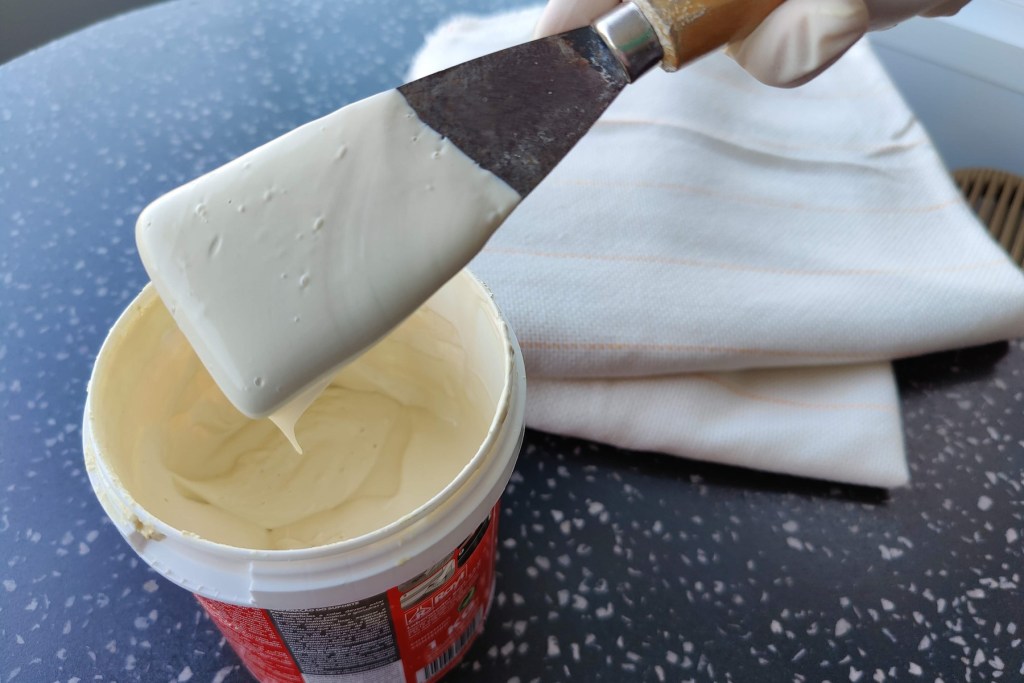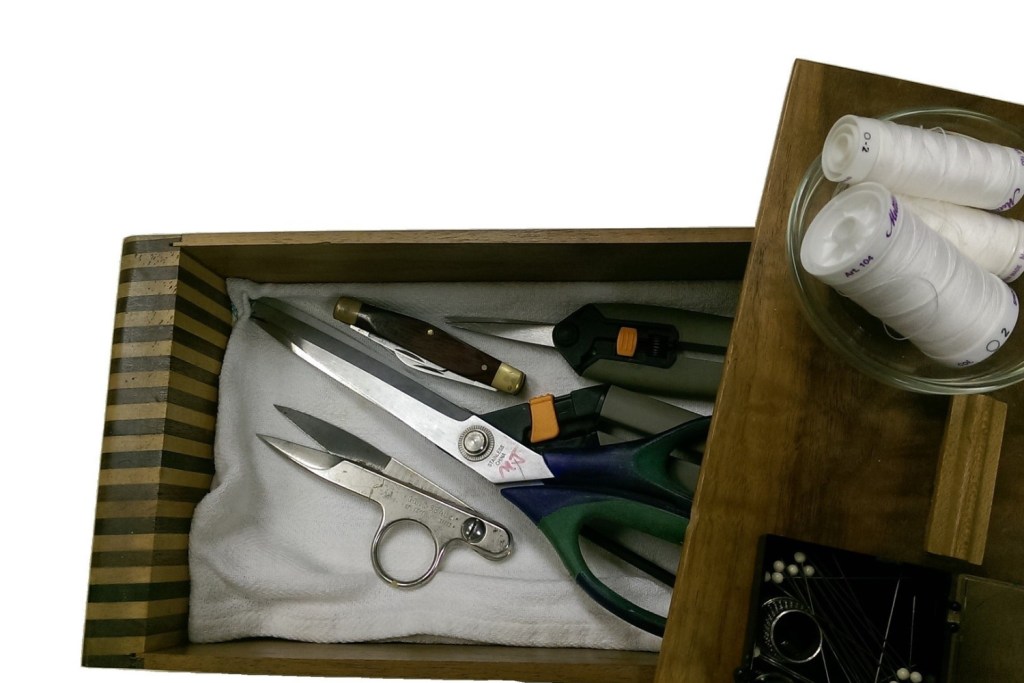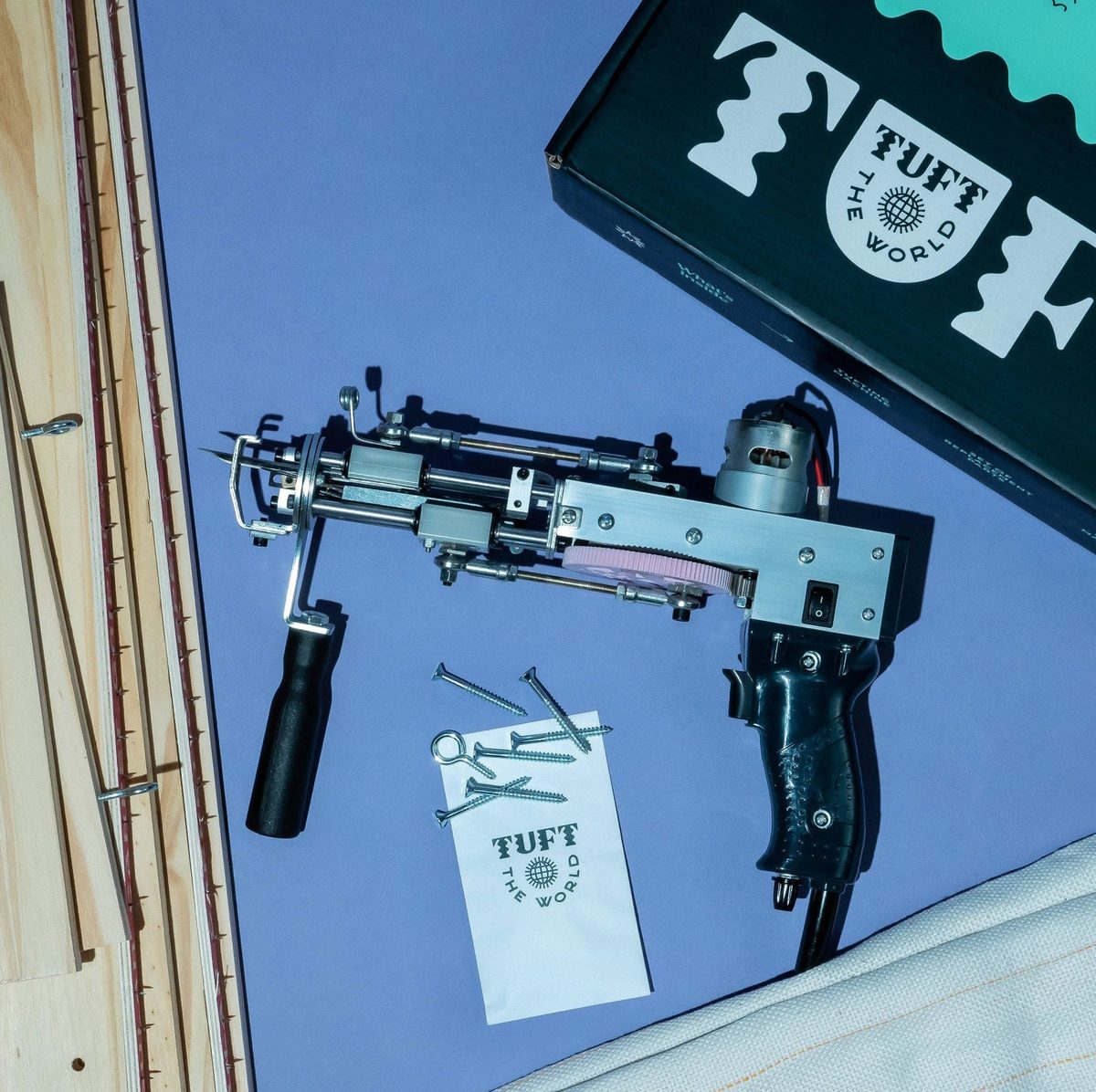Rug tufting has become fairly popular in recent years, and if you’ve ever seen the process, it isn’t hard to see why. Just check out the amazing rug tufting artists all over TikTok!
With just a couple of materials, you can create large and functional art pieces in any shape or size. Rug making can be incredibly fun and rewarding, and you can create custom rugs for your home, give them as gifts, or even sell them online.
But how do you get started?
You’ll need a few specialty tufting supplies, and that’s what this guide is all about. We’ll cover everything you need to consider and purchase before you begin tufting some fun rugs of your own.
Affiliate disclosure: Articles on Tiny Workshops may contain affiliate links.
Before you get started

Before you grab your tufting gun and yarn and start whipping up some tufted art, there are a few things you should know.
For starters, because of the current popularity of rug tufting, procuring the necessary tufting supplies for your new pastime might be a bit of a challenge.
Don’t worry on that front, though. I’ll give you plenty of recommendations on where to source the best tufting supplies.
As for skill requirements, tufting is a pretty beginner-friendly process and, therefore, an inviting creative hobby for complete newbies. The tufting gun, a staple of the craft, can seem intimidating, but trust me, it’s much easier to use than it looks — and it’s also super fun!
If you just want to hop right into things, check out the full starter kit below, and be sure to use the code TINY at checkout to save 15%! The only thing missing is yarn.
Want to get started tufting right away? This starter kit from Tuft the World has just what you need to tuft your first rug. Includes a tufting gun, frame, and tufting cloth.
Essential rug tufting supplies
When it comes to tufting supplies, there are a few things you need to get started. Here’s a breakdown of the essentials (plus a few nice-to-haves)!
Tufting gun

The tufting gun is the most significant investment out of all the tufting supplies you’ll need, but it’s also what makes this craft so easy and fun.
On the off chance you haven’t seen one, a tufting gun is sort of like a handheld sewing machine that allows you to push yarn into cloth to create rugs in all kinds of shapes, patterns, and sizes. When it comes to rug tufting, this item has the highest upfront cost, but you absolutely don’t want to skimp on this one.
Also, there are a lot of fake products on the market, so this isn’t something you’ll want to purchase on Amazon.
Before selecting your tufting gun, you first need to decide if you want a loop pile or a cut pile model. Some models offer both of these options in one gun, but they can be tricky to use (and more expensive). If you’re a beginner, it’s best to stick with something easy at first.
I’ve written a whole guide to tufting guns if you want to learn more, but the short version is that there are three main tufting guns to get: The Duo (cut and loop pile), the AK-I (cut pile), and the AK-II (loop pile).
The Duo is the main one I’d recommend since it’s capable of both cut and loop pile tufting. It can be a bit of a learning process to switch between the two, but you don’t have to if you don’t want to. It’s also quite affordable.
(PS: Use the code TINY at checkout to save 15% on purchases at Tuft the World!)
If you choose to go with a cut pile gun, the AK-I is a fantastic beginner option. It’s simple to set up, user-friendly, and very light. With all tufting guns, I would not recommend buying on Amazon, but this Etsy store delivers around the world in roughly a week.
If you opt for a loop pile gun, the AK-II has the same benefits as its aforementioned counterpart but creates a different rug type. Like above, you can have it at your doorstep in a week if you order it from this Etsy store.
Beyond that, there are pneumatic tufting guns, which are far too pricey for beginners. You’ll also need a compressed air machine, which will add a few hundred dollars to your startup costs.
It’s important to keep in mind that there are ways to make a rug without a tufting gun. A punch needle is used to push the yarn through a rug backing by hand; the process takes longer than using a tufting gun, but the results can be just as stunning.
Check out a few of our favorite punch needle kits if you’re interested!
You can also use a latch hook, which is a small hook-like tool used to pull yarn through a mesh latch hook canvas. This method is also the safest, making it a nice kid-friendly craft. There are also many cool options for this; check out our list of the best latch hook kits to learn more.
Tufting yarn

Yarn is one of the tufting supplies you’ll need the most, but it’s also inexpensive. You can get different types of yarn depending on what kind of project you’re working on and how you want your finished product to feel.
Three popular choices of tufting yarn materials are acrylic, cotton, and wool. All can be great options, and their use simply depends on your rug’s design. Acrylic tends to have a shorter and flatter pile, while wool tends to be softer and feel thicker.
While most yarn (even chunky yarn, to a degree) will work well for tufting, each type of yarn and yarn weight delivers different results. Acrylic is the most cost-effective but least soft, and wool is the hardest wearing (and nicest) but most expensive. Cotton lies somewhere right in between.
When it comes to purchasing yarn, you have plenty of options. Acrylic yarn is easy to find anywhere, but this one has worked well for me in the past. This Etsy shop and Tuft the World sell wool and cotton yarn on convenient cardboard cones. Remember to use the code TINY when buying from Tuft the World to save 15%!
If you don’t need the cones (or have your own yarn winder), you can get tons of great yarn from online shops like Lovecrafts or local craft stores.
Check out my list of the best yarn for tufting rugs for more options (and my top picks!).
Tufting backing cloth

When speaking of tufting supplies, backing cloth is another essential item you’ll need and, like yarn, has some variance. The type of backing cloth you’ll want to purchase depends, once again, on your project, skill level, and budget.
The most beginner-friendly cloth to purchase is primary tufting cloth, which is a cotton and polyester blend. It’s durable and made specifically for easy tufting. It also generally features guidelines to help you space things out as you work.
You can purchase it on Amazon, but I prefer buying from Etsy to support small businesses. It’s also sold on Tuft the World in two colors (white and gray). Don’t forget to save 15% with the code TINY at checkout!
Another option for tufting is burlap, which has strands that are more spaced out and offer plenty of room for tufting. It’s extremely inexpensive, but it isn’t the easiest to work with and may result in some tearing. Still, it’s perfect for practice rugs and quick projects. You can buy it here or in just about any store that sells hobby and tufting supplies.
Monk’s cloth and linen are also good options, and they fall somewhere between the two. They’re a bit more expensive than burlap, but either can be purchased just about anywhere. Here’s one on Amazon that’s a decent value.
Using some non-slip backing material under your rug may also be a good idea as you evolve in the craft. While it’s not one of the can’t-do-without tufting supplies and is entirely optional, it does help keep your rug in place after being positioned.
Often called “secondary” tufting cloth, you can sew or adhere this on after completing your rug and putting on your rug adhesive. Check out options on Amazon and Tuft the World.
You can find more suggestions and handy tips about this essential material in my rug tufting cloth guide.
Tufting Frame

To properly create your tufted rug, you’ll need a tufting frame. A tufting frame allows you to stretch your tufting backing cloth vertically to efficiently work on your rug without worrying about your cloth rolling up on you or having any surface beneath your rug caught in your yarn.
The beauty of using a frame is that it can be as large or small as you want, depending on the scope of your project. Your frame should be something you can easily remove staples or nails from, seeing that this is the most practical way to adhere backing cloth onto the structure.
That said, wood is a pretty safe and effective option here. The frame should also allow you to pull the cloth as tight as possible for an optimal tufting surface.
Another great perk about tufting frames? You can make them yourself and save quite a bit of money! Pre-built frames can be expensive. Just make sure to use wood or another material from which your backing cloth can easily be removed. I recommend using carpet tack strips instead of staples, as these are inexpensive and convenient.
If you think you’d rather have a pre-made tufting frame, you can once again turn to Etsy or an online specialty tufting shop like Tuft the World to pick one up. The latter runs a bit more expensive, but you can save 15% at checkout with the code TINY.
Rug adhesive

To complete your rug, you’ll need a rug adhesive to keep all the strands of yarn together. Adding rug adhesive is a crucial step that keeps your rug from falling to bits, so when buying tufting supplies, you’ll want to stock up.
There are plenty of different types of rug adhesive you can purchase, all with varying dry times and capabilities. The one you select will depend on your personal preference and skill level, as well as what your rug is being used for.
Some of the main types of rug adhesive are latex-based, PVC-based, and vinyl-based. If you intend to leave your rug on the floor, a latex adhesive such as Roberts 3095 is my top choice.
For more professional rugs, Roberts 6700 is a bit harder wearing, and the specialty tufting glue TN-100 is a bit thinner and dries faster. For wall rugs that won’t see any foot traffic, simple Elmer’s Glue-All can definitely get the job done, but it will dry rigid.
You can also check out my in-depth guide on the best glue for tufting for more options and information before making your purchase!
Other tufting supplies

While we covered the main tufting supplies you need to create your first rug, there are a few optional materials.
One very cheap tufting supply you may already have at home is oil. I have a guide to choosing the right tufting gun oil (spoiler: just get 3-in-One), as well as a guide to how to oil your tufting gun to walk you through the process.
If you want to put a specific character or design on a rug, having an art projector might help you make it exact. You can easily project the image onto your backing fabric and not have to worry about trying to freehand.
Shears are a slightly less optional tufting supply, as you need something to cut your backing fabric and trim excess yarn. You could use regular scissors, but a good pair of sewing shears just can’t be beaten.
If you want something a bit more specialized, these duckbill scissors are designed especially for rug making. Electric scissors are also a great alternative for frequent tufters.
For faster and more precise trimming of your finished rug, you might also want a hair trimmer. If you have one lying around, you could use a hair or pet trimmer, or grab these particular clippers and give your rug the perfect haircut!
If you find yourself purchasing a lot of yarn for this new hobby, you might want to invest in some yarn cones or feeders. Yarn cones are good for storing your yarn, while yarn feeders make it easy to keep your yarn untangled as you use your tufting gun.
If you purchase skeins of yarn instead of cones, consider picking up a yarn swift to turn them into cones or cakes for easy feeding. This also allows you to double-thread your cone, which I highly recommend for the best results in your rugs.
That’s it for all of the essential rug tufting supplies you need to get started! Feel free to drop any questions, comments, or tips for other readers below.


Leave a Reply